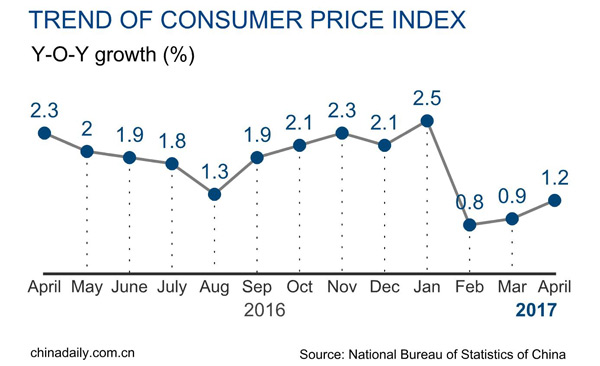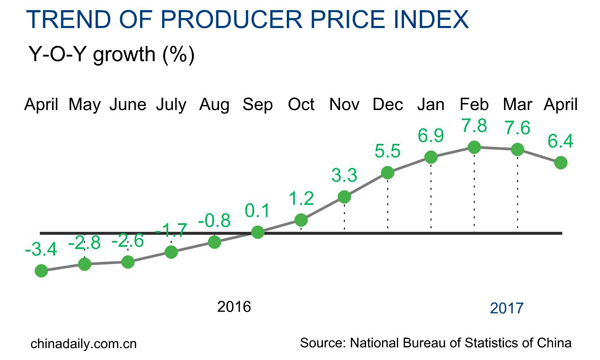
Growth of China's consumer inflation accelerated in April, as higher non-food prices outweighed continued decline in food prices, official data showed Wednesday.
Consumer price index (CPI), a main gauge of inflation, rose 1.2 percent year on year in April, according to the National Bureau of Statistics (NBS), outpacing market estimates of 1.1 percent.
The growth quickened from March's 0.9 percent expansion and February's 0.8 percent. On a monthly basis, the CPI climbed 0.1 percent.
NBS attributed the pick-up in CPI to higher non-food prices, which grew 2.4 percent year on year in April and rose 0.2 percent over March.
Two national holidays in April had driven up prices for air tickets, hotels and travel services, contributing to the accelerating CPI increase, NBS senior statistician Sheng Guoqing said.
Food prices declined 3.5 percent as vegetable prices fell 21.6 percent from a year earlier on ample supplies. The costs of pork and eggs dropped 8.1 percent and 11.4 percent, respectively.
Excluding volatile food and energy prices, the core CPI increased 2.1 percent in April from a year ago, almost on par with the last reading.
Bloomberg economist Tom Orlik expected the CPI growth to rise in the months ahead, but not high enough to shift the central bank off its cautious, incremental tightening path.
CPI increased 1.4 percent in the first four months of the year. The government aims to keep consumer inflation at around 3 percent this year.

The producer price index (PPI), which measures costs of goods at the factory gate, rose 6.4 percent year on year in April, down from 7.6 percent in March and missing expectations of 6.7 percent.
Slumping commodity prices are the main driver of smaller gains in the PPI, but robust demand, efforts to close excess capacity and a weaker yuan, which increases import prices, will prevent a sharper slide in factory-gate inflation, Orlik said.
On a monthly basis, the PPI fell 0.4 percent, the first month-on-month decline since July.
Lian Ping, chief economist at Bank of Communications, said the PPI increase may continue to ease over the rest of 2017 with February being the peak of the year.
The steady price data reinforced views about stabilization in the world's second-largest economy. China's GDP grew 6.9 percent in the first quarter of the year, up from 6.8 percent in the last quarter of 2016 and official target of around 6.5 percent set for the year.
Chinese stocks edged up after the release of the data. The benchmark Shanghai Composite Index added 0.26 percent to end the morning session at 3,088.63 points.


















































